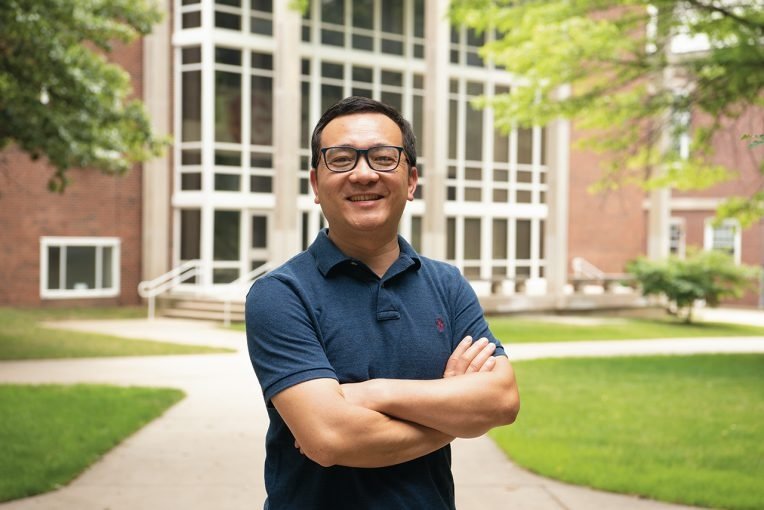AI Research
Kennesaw State secures NSF grants to build community of AI educators nationwide

KENNESAW, Ga. |
Sep 12, 2025
The International Data Corporation projects that artificial intelligence will add
$19.9 trillion to the global economy by 2030, yet educators are still defining how
students should learn to use the technology responsibly.
To better equip AI educators and to foster a sense of community among those in the
field, Kennesaw State University Department Chair and Professor of Information Technology (IT) Shaoen Wu, along with assistant professors Seyedamin Pouriyeh and Chloe “Yixin” Xie, were recently awarded two National Science Foundation (NSF) grants. The awards, managed by the NSF’s Computer and Information Science and Engineering division, will fund the project through May 31, 2027 with an overarching goal to unite educators from across the country
to build shared resources, foster collaboration, and lay the foundation for common
guidelines in AI education.
Wu, who works in Kennesaw State’s College of Computing and Software Engineering (CCSE), explained that while many universities, including KSU, have launched undergraduate
and graduate programs in artificial intelligence, there is no established community
to unify these efforts.
“AI has become the next big thing after the internet,” Wu said. “But we do not yet have a mature, coordinated community for AI education. This project is the first step toward building that national network.”
Drawing inspiration from the cybersecurity education community, which has long benefited
from standardized curriculum guidelines, Wu envisions a similar structure for AI.
The goal is to reduce barriers for under-resourced institutions, such as community
colleges, by giving them free access to shared teaching materials and best practices.
The projects are part of the National AI Research Resource (NAIRR) pilot, a White
House initiative to broaden AI access and innovation. Through the grants, Wu and his
team will bring together educators from two-year colleges, four-year institutions,
research-intensive universities, and Historically Black Colleges and Universities
to identify gaps and outline recommendations for AI education.
“This is not just for computing majors,” Wu said. “AI touches health, finance, engineering, and so many other fields. What we build now will shape AI education not only in higher education but also in K-12 schools and for the general public.”
For Wu, the NSF grants represent more than just funding. It validates KSU’s growing presence in national conversations on emerging technologies. Recently, he was invited to moderate a panel at the Computing Research Association’s annual computing academic leadership summit, where department chairs and deans from across the country gathered to discuss AI education.
“These grants position KSU alongside institutions like the University of Illinois Urbana-Champaign and the University of Pennsylvania as co-leaders in shaping the future of AI education,” Wu said. “It is a golden opportunity to elevate our university to national and even global prominence.”
CCSE Interim Dean Yiming Ji said Wu’s leadership reflects CCSE’s commitment to both innovation and accessibility.
“This NSF grant is not just an achievement for Dr. Wu but for the entire College of Computing and Software Engineering,” Ji said. “It highlights our faculty’s work to shape national conversations in AI education while ensuring that students from all backgrounds, including those at under-resourced institutions, can benefit from shared knowledge and opportunities.”
– Story by Raynard Churchwell
Related Stories
A leader in innovative teaching and learning, Kennesaw State University offers undergraduate, graduate, and doctoral degrees to its more than 47,000 students. Kennesaw State is a member of the University System of Georgia with 11 academic colleges. The university’s vibrant campus culture, diverse population, strong global ties, and entrepreneurial spirit draw students from throughout the country and the world. Kennesaw State is a Carnegie-designated doctoral research institution (R2), placing it among an elite group of only 8 percent of U.S. colleges and universities with an R1 or R2 status. For more information, visit kennesaw.edu.
AI Research
NFL player props, odds: Week 2, 2025 NFL picks, SportsLine Machine Learning Model AI predictions, SGP

The Under went 12-4 in Week 1, indicating that not only were there fewer points scored than expected, but there were also fewer yards gained. Backing the Under with NFL prop bets was likely profitable for the opening slate of games, but will that maintain with Week 2 NFL props? Interestingly though, four of the five highest-scoring games last week were the primetime games, so if that holds, then the Overs for this week’s night games could be attractive with Week 2 NFL player props.
There’s a Monday Night Football doubleheader featuring star pass catchers like Nico Collins, Mike Evans and Brock Bowers. The games also feature promising rookies such as Ashton Jeanty, Omarion Hampton and Emeka Egbuka. Prop lines are usually all over the place early in the season as sportsbooks attempt to establish a player’s potential, and you could take advantage of this with the right NFL picks. If you are looking for NFL prop bets or NFL parlays for Week 2, SportsLine has you covered with the top Week 2 player props from its Machine Learning Model AI.
Built using cutting-edge artificial intelligence and machine learning techniques by SportsLine’s Data Science team, AI Predictions and AI Ratings are generated for each player prop.
Now, with the Week 2 NFL schedule quickly approaching, SportsLine’s Machine Learning Model AI has identified the top NFL props from the biggest Week 2 games.
Week 2 NFL props for Sunday’s main slate
After analyzing the NFL props from Sunday’s main slate and examining the dozens of NFL player prop markets, the SportsLine’s Machine Learning Model AI says Lions receiver Amon-Ra St. Brown goes Over 63.5 receiving yards (-114) versus the Bears at 1 p.m. ET. Detroit will host this contest, which is notable as St. Brown has averaged 114 receiving yards over his last six home games. He had at least 70 receiving yards in both matchups versus the Bears a year ago.
Chicago allowed 12 receivers to go Over 63.5 receiving yards last season as the Bears’ pass defense is adept at keeping opponents out of the endzone but not as good at preventing yardage. Chicago allowed the highest yards per attempt and second-highest yards per completion in 2024. While St. Brown had just 45 yards in the opener, the last time he was held under 50 receiving yards, he then had 193 yards the following week. The SportsLine Machine Learning Model projects 82.5 yards for St. Brown in a 4.5-star pick. See more Week 2 NFL props here.
Week 2 NFL props for Vikings vs. Falcons on Sunday Night Football
After analyzing Falcons vs. Vikings props and examining the dozens of NFL player prop markets, the SportsLine’s Machine Learning Model AI says Falcons running back Bijan Robinson goes Over 65.5 rushing yards (-114). Robinson ran for 92 yards and a touchdown in Week 14 of last season versus Minnesota, despite the Vikings having the league’s No. 2 run defense a year ago. The SportsLine Machine Learning Model projects Robinson to have 81.8 yards on average in a 4.5-star prop pick. See more NFL props for Vikings vs. Falcons here.
You can make NFL prop bets on Robinson, Justin Jefferson and others with the Underdog Fantasy promo code CBSSPORTS2. Pick at Underdog Fantasy and get $50 in bonus funds after making a $5 wager:
Week 2 NFL props for Buccaneers vs. Texans on Monday Night Football
After analyzing Texans vs. Buccaneers props and examining the dozens of NFL player prop markets, the SportsLine’s Machine Learning Model AI says Bucs quarterback Baker Mayfield goes Under 235.5 passing yards (-114). While Houston has questions regarding its offense, there’s little worry about the team’s pass defense. In 2024, Houston had the second-most interceptions, the fourth-most sacks and allowed the fourth-worst passer rating. Since the start of last year, and including the playoffs, the Texans have held opposing QBs under 235.5 yards in 13 of 20 games. The SportsLine Machine Learning Model forecasts Mayfield to finish with just 200.1 passing yards, making the Under a 4-star NFL prop. See more NFL props for Buccaneers vs. Texans here.
You can also use the latest FanDuel promo code to get $300 in bonus bets instantly:
Week 2 NFL props for Chargers vs. Raiders on Monday Night Football
After analyzing Raiders vs. Chargers props and examining the dozens of NFL player prop markets, the SportsLine’s Machine Learning Model AI says Chargers quarterback Justin Herbert goes Under 254.5 passing yards (-114). The Raiders’ defense was underrated in preventing big passing plays a year ago as it ranked third in the NFL in average depth of target allowed. It forced QBs to dink and dunk their way down the field, which doesn’t lead to big passing yardages, and L.A. generally prefers to not throw the ball anyway. Just four teams attempted fewer passes last season than the Chargers, and with L.A. running for 156.5 yards versus Vegas last season, Herbert shouldn’t be overly active on Monday night. He’s forecasted to have 221.1 passing yards in a 4.5-star NFL prop bet. See more NFL props for Chargers vs. Raiders here.
How to make Week 2 NFL prop picks
SportsLine’s Machine Learning Model has identified another star who sails past his total and has dozens of NFL props rated 4 stars or better. You need to see the Machine Learning Model analysis before making any Week 2 NFL prop bets.
Which NFL prop picks should you target for Week 2, and which quarterback has multiple 5-star rated picks? Visit SportsLine to see the latest NFL player props from SportsLine’s Machine Learning Model that uses cutting-edge artificial intelligence to make its projections.
AI Research
In the News: Thomas Feeney on AI in Higher Education – Newsroom

“I had an interesting experience over the summer teaching an AI ethics class. You know plagiarism would be an interesting question in an AI ethics class … They had permission to use AI for the first written assignment. And it was clear that many of them had just fed in the prompt, gotten back the paper and uploaded that. But rather than initiate a sort of disciplinary oppositional setting, I tried to show them, look, what you what you’ve produced is kind of generic … and this gave the students a chance to recognize that they weren’t there in their own work. This opened the floodgates,” Feeney said.
“I think the focus should be less on learning how to work with the interfaces we have right now and more on just graduate with a story about how you did something with AI that you couldn’t have done without it. And then, crucially, how you shared it with someone else,” he continued.
AI Research
Philippines businesses remain slow in adopting AI – study – Philstar.com
-

 Business2 weeks ago
Business2 weeks agoThe Guardian view on Trump and the Fed: independence is no substitute for accountability | Editorial
-
Tools & Platforms1 month ago
Building Trust in Military AI Starts with Opening the Black Box – War on the Rocks
-

 Ethics & Policy2 months ago
Ethics & Policy2 months agoSDAIA Supports Saudi Arabia’s Leadership in Shaping Global AI Ethics, Policy, and Research – وكالة الأنباء السعودية
-

 Events & Conferences4 months ago
Events & Conferences4 months agoJourney to 1000 models: Scaling Instagram’s recommendation system
-

 Jobs & Careers2 months ago
Jobs & Careers2 months agoMumbai-based Perplexity Alternative Has 60k+ Users Without Funding
-

 Podcasts & Talks2 months ago
Podcasts & Talks2 months agoHappy 4th of July! 🎆 Made with Veo 3 in Gemini
-

 Education2 months ago
Education2 months agoMacron says UK and France have duty to tackle illegal migration ‘with humanity, solidarity and firmness’ – UK politics live | Politics
-

 Education2 months ago
Education2 months agoVEX Robotics launches AI-powered classroom robotics system
-

 Podcasts & Talks2 months ago
Podcasts & Talks2 months agoOpenAI 🤝 @teamganassi
-

 Funding & Business2 months ago
Funding & Business2 months agoKayak and Expedia race to build AI travel agents that turn social posts into itineraries


